Structural Analysis of Large-Scale Vertical Axis Wind Turbines Part II: Fatigue and Ultimate Strength Analyses
Abstract
:1. Introduction
2. Analysis Framework
3. External and Operational Conditions in Analyses
4. Modeling and Structural Analysis of a Laminated Blade
4.1. FE Modeling of a Laminated Blade
4.2. Fatigue Analysis
- (1)
- The node of the largest εx range with positive mean at the lower support, which is located at the thickest portion of the blade section in the tower side, is defined as Node 1.
- (2)
- The node of the largest εx range with negative mean at the lower support, which is located at the thickest portion of the blade section in the outer side, is defined as Node 2. Nodes 1 and 2 are on the outer shell of the blade.
- (3)
- The node of the largest εx range with positive mean value in the shear web, which is at the lower support, is denoted as Node 3.
- (4)
- The node of the largest strain range with a negative mean value in the shear web, which is also at the shear web, is denoted as Node 4. Node 3 is adjacent to Node 1, and Node 4 is adjacent to Node 2.
- (5)
- For εy, the largest strain ranges with positive and negative mean values occur at the bond joint connecting the shear web to the outer shell of the blade at the lower support. Node 5 is defined as the node of the largest εy range with positive strain, which is at the bond joint connecting the shear web to the outer shell of the blade at the lower support.
- (6)
- The node of the largest negative strain range, which is also at the bond joint connecting the shear web to the outer shell of the blade at the lower support and near Node 5, is defined as Node 6.
4.3. Ultimate Strength Analysis
5. Modeling and Structural Analysis of the Entire VAWT
5.1. FE Modeling of a Straight-Bladed VAWT
5.2. Fatigue Analysis
5.3. Ultimate Strength Analysis
6. Conclusions
- (1)
- The fatigue-critical locations of the blades under power production and normal turbulent wind conditions were determined. Locations at the supports and the mid-span of the blade exhibited larger fatigue damage than other positions. The largest fatigue damage occurred at the cross-section of the lower support, where compressive loads demonstrated larger fatigue damage than tensile cyclic loads.
- (2)
- The ultimate strength analysis of the blade under extreme wind speed conditions was also considered. In this case, the wind turbine was parked. The influence of the wind direction on the responses of the blade was studied. The highly unfavorable azimuth angle is in the upwind side, which is in the range between 60° and 90°. The failure-critical location is in the cross-section of the upper support. The locations with large inter-laminar stresses, besides the critical-failure ones predicted by the Tsai–Wu criteria, were also determined.
- (3)
- The fatigue analysis was conducted on the basis of the FE model and rotating frame method. The largest fatigue damage occurred at the root of the main arms. Although the fatigue damage of the shaft was small for this typical VAWT, it cannot be ignored, because the misalignment of the rotor and eccentric mass were not considered here. The fatigue-critical location of the tower was at the bottom, and the fatigue damage of the tower was calculated. Significant fatigue damage occurred at the leeward side of the tower.
- (4)
- An ultimate strength analysis of the rotor and tower was conducted. The von Mises stresses of the rotor and tower were calculated. The largest stress on the components occurred at the fatigue-critical locations.
Author Contributions
Funding
Acknowledgments
Conflicts of Interest
References
- Ashwill, T.D.; Sutherland, H.J.; Berg, D.E. A Retrospective of VAWT Technology; Technical Reports; Sandia National Laboratories: Albuquerque, NM, USA, 2012. [Google Scholar]
- Kooiman, S.J.; Tullis, S.W. Response of a Vertical Axis Wind Turbine to Time Varying Wind Conditions found within the Urban Environment. Wind. Eng. 2010, 34, 389–402. [Google Scholar] [CrossRef]
- Peng, H.; Lam, H. Turbulence effects on the wake characteristics and aerodynamic performance of a straight-bladed vertical axis wind turbine by wind tunnel tests and large eddy simulations. Energy 2016, 109, 557–568. [Google Scholar] [CrossRef]
- Ahmadi-Baloutaki, M.; Carriveau, R.; Ting, D.S.-K. Performance of a vertical axis wind turbine in grid generated turbulence. Sustain. Technol. Assess. 2015, 11, 178–185. [Google Scholar] [CrossRef]
- Dabiri, J.O. Potential order-of-magnitude enhancement of wind farm power density via counter-rotating vertical-axis wind turbine arrays. J. Renew. Sustain. Energy 2011, 3, 43104. [Google Scholar] [CrossRef] [Green Version]
- Ryan, K.J.; Coletti, F.; Elkins, C.J.; Dabiri, J.O.; Eaton, J.K. Three-dimensional flow field around and downstream of a subscale model rotating vertical axis wind turbine. Exp. Fluids 2016, 57, 38. [Google Scholar] [CrossRef]
- Albers, A. Turbulence and shear normalization of wind turbine power curve. In Proceedings of the EWEC 2010, Warsaw, Poland, 20–23 April 2010; Volume 6, pp. 4116–4123. [Google Scholar]
- Pagnini, L.C.; Burlando, M.; Repetto, M.P. Experimental power curve of small-size wind turbines in turbulent urban environment. Appl. Energy 2015, 154, 112–121. [Google Scholar] [CrossRef]
- International Renewable Energy Agency. Wind Power, Renewable Energy Technologies: Cost Analysis Series; International Renewable Energy Agency: Abu Dhabi, United Arab Emirates, 2012; Volume 1, Power Sector, Issue 5. [Google Scholar]
- Gipe, P. Wind Energy—The Breath of Life or the Kiss of Death: Contemporary Wind Mortality Rates. Available online: http://www.wind-works.org/articles/BreathLife.html (accessed on 10 February 2005).
- Castelli, M.R.; Monte, A.D.; Quaresimin, M.; Benini, E. Numerical evaluation of aerodynamic and inertial contributions to Darrieus wind turbine blade deformation. Renew. Energy 2013, 51, 101–112. [Google Scholar] [CrossRef]
- Jensen, F.; Falzon, B.; Ankersen, J.; Stang, H.; Falzon, B. Structural testing and numerical simulation of a 34m composite wind turbine blade. Compos. Struct. 2006, 76, 52–61. [Google Scholar] [CrossRef]
- Jung, S.N.; Dhadwal, M.K.; Kim, Y.W.; Kim, J.H.; Riemenschneider, J. Cross-sectional constants of composite blades using computed tomography technique and finite element analysis. Compos. Struct. 2015, 129, 132–142. [Google Scholar] [CrossRef]
- Peeters, M.; Santo, G.; Degroote, J.; Van Paepegem, W. Comparison of Shell and Solid Finite Element Models for the Static Certification Tests of a 43 m Wind Turbine Blade. Energies 2018, 11, 1346. [Google Scholar] [CrossRef]
- Song, S.H.; Kang, S.I.; Hahm, N.K. Optimization design, modeling and dynamic analysis for composite wind turbine blade. Procedia Eng. 2011, 16, 369–375. [Google Scholar] [CrossRef]
- Kang, N.; Park, S.C.; Park, J.; Atluri, S.N. Dynamics of flexible tower-blade and rigid nacelle system: Dynamic instability due to their interactions in wind turbine. J. Vib. Control 2016, 22, 826–836. [Google Scholar] [CrossRef]
- Kessentini, S.; Choura, S.; Najar, F.; Franchek, M. Modeling and Dynamics of a Horizontal Axis Wind Turbine. J. Vib. Control 2010, 16, 2001–2021. [Google Scholar] [CrossRef]
- Luo, T.; Tian, D.; Wang, R.Y.; Liao, C.C. Stochastic Dynamic Response Analysis of a 10 MW Tension Leg Platform Floating Horizontal Axis Wind Turbine. Energies 2018, 11, 3341. [Google Scholar] [CrossRef]
- Saravia, C.M.; Machado, S.P.; Cortínez, V.H. A composite beam finite element for multibody dynamics: Application to large wind turbine modeling. Eng. Struct. 2013, 56, 1164–1176. [Google Scholar] [CrossRef]
- Berg, D.E. Structural Design of the Sandia 34-m Vertical-Axis Wind Turbine; Nasa Sti/recon Technical Report N,85; Sandia National Laboratories: Albuquerque, NM, USA, 1985. [Google Scholar]
- Lobitz, D.W.; Ashwill, T. Aeroelastic Effects in the Structural Dynamic Analysis of Vertical Axis Wind Turbines; Sandia National Labs.: Albuquerque, NM, USA, 1986. [Google Scholar]
- Popelka, D. Aeroelastic Stability Analysis of a Darrieus Wind Turbine; Sandia National Laboratories: Albuquerque, NM, USA, 1982. [Google Scholar]
- Carne, T.; Lobitz, D.; Nord, A.; Watson, R. Finite element analysis and modal testing of a rotating wind turbine. In Proceedings of the 23rd Structures, Structural Dynamics and Materials Conference, New Orleans, LA, USA, 10–12 May 1982. [Google Scholar]
- Thresher, R.W.; Mirandy, L.P.; Carne, T.G.; Lobitz, D.W.; James, G.H. Structural Dynamic Behavior of Wind Turbines Wind Turbine Technology: Fundamental Concepts in Wind Turbine Engineering, 2nd ed.; ASME Press: Fairfield, NJ, USA, 2009. [Google Scholar]
- Lin, J.H.; Xu, Y.L.; Xia, Y.; Li, C. Structural Analysis of Large-Scale Vertical-Axis Wind Turbines I: Wind Load Simulation. Energies 2019. submitted for publication. [Google Scholar]
- International Electrotechnical Commission. IEC 61400-1: Wind Turbines Part 1: Design Requirements. Ed 3.; IEC: Geneva, Switzerland, 2015. [Google Scholar]
- Germanischer, Lloyd. Guideline for the Certification of Wind Turbines; Germanischer Lloyd Industrial Services GmbH: Hamburg, Germany, 2010. [Google Scholar]
- ANSYS Inc. Programmer’s Manual for ANSYS; ANSYS Inc.: Pittsburgh, PA, USA, 2007. [Google Scholar]
- Burton, T.; Jenkins, N.; Sharpe, D.; Bossanyi, E. Wind Energy Handbook; John Wiley & Sons: Somerset, NJ, USA, 2001. [Google Scholar]
- Kong, C.; Bang, J.; Sugiyama, Y. Structural investigation of composite wind turbine blade considering various load cases and fatigue life. Energy 2005, 30, 2101–2114. [Google Scholar] [CrossRef]
- Sutherland, H.J. On the Fatigue Analysis of Wind Turbines; Sandia National Laboratories: Albuquerque, NM, USA, 1999. [Google Scholar]
- Quaresimin, M. 50th Anniversary Article: Multiaxial Fatigue Testing of Composites: From the Pioneers to Future Directions. Strain 2015, 51, 16–29. [Google Scholar] [CrossRef]
- Quaresimin, M.; Susmel, L.; Talreja, R. Fatigue behaviour and life assessment of composite laminates under multiaxial loadings. Int. J. Fatigue 2010, 32, 2–16. [Google Scholar] [CrossRef]
- Repetto, M.P.; Torrielli, A. Long term simulation of wind-induced fatigue loadings. Eng. Struct. 2017, 132, 551–561. [Google Scholar] [CrossRef]
- Brøndsted, P.; Lilholt, H.; Lystrup, A. COMPOSITE MATERIALS FOR WIND POWER TURBINE BLADES. Annu. Rev. Mater. Res. 2005, 35, 505–538. [Google Scholar] [CrossRef]
- Budiansky, B.; Fleck, N. Compressive failure of fibre composites. J. Mech. Phys. Solids 1993, 41, 183–211. [Google Scholar] [CrossRef]
- Tsai, S.W.; Wu, E.M. A General Theory of Strength for Anisotropic Materials. J. Compos. Mater. 1971, 5, 58–80. [Google Scholar] [CrossRef]
- Mandell, J.F.; Samborsky, D.D. DOE/MSU Composite Material Fatigue Database. Version, 18; Montana State University: Bozeman, MT, USA, 2009. [Google Scholar]
- De Normalisation, C.E. Eurocode 2: Design of Concrete Structures: Part 1: General Rules and Rules for Buildings; European Committee for Standardization: Brussels, Belgium, 1991. [Google Scholar]
- German Institute for Standardization. DIN 1045-1; German Institute for Standardization: Berlin, Germany, 2003. [Google Scholar]


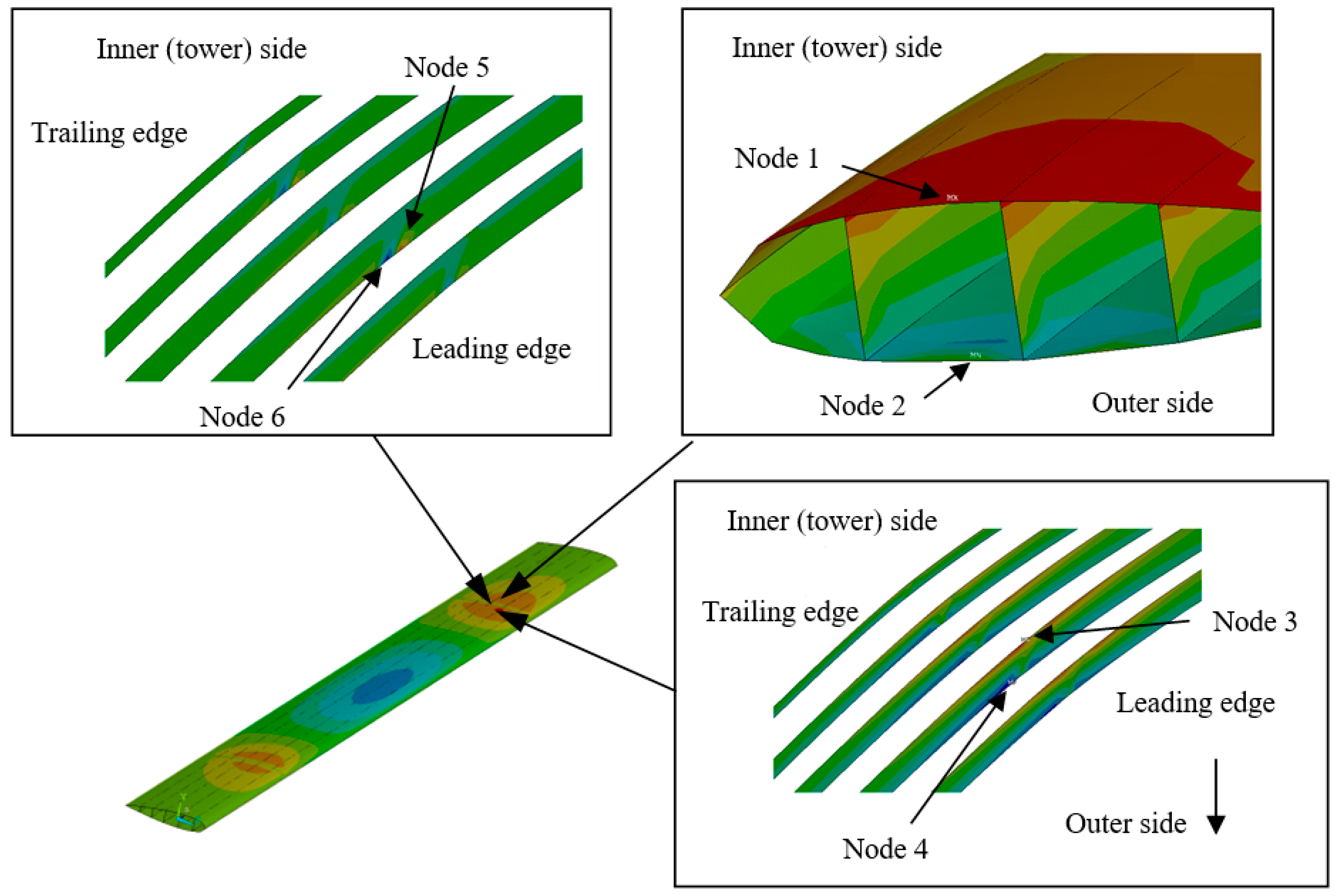
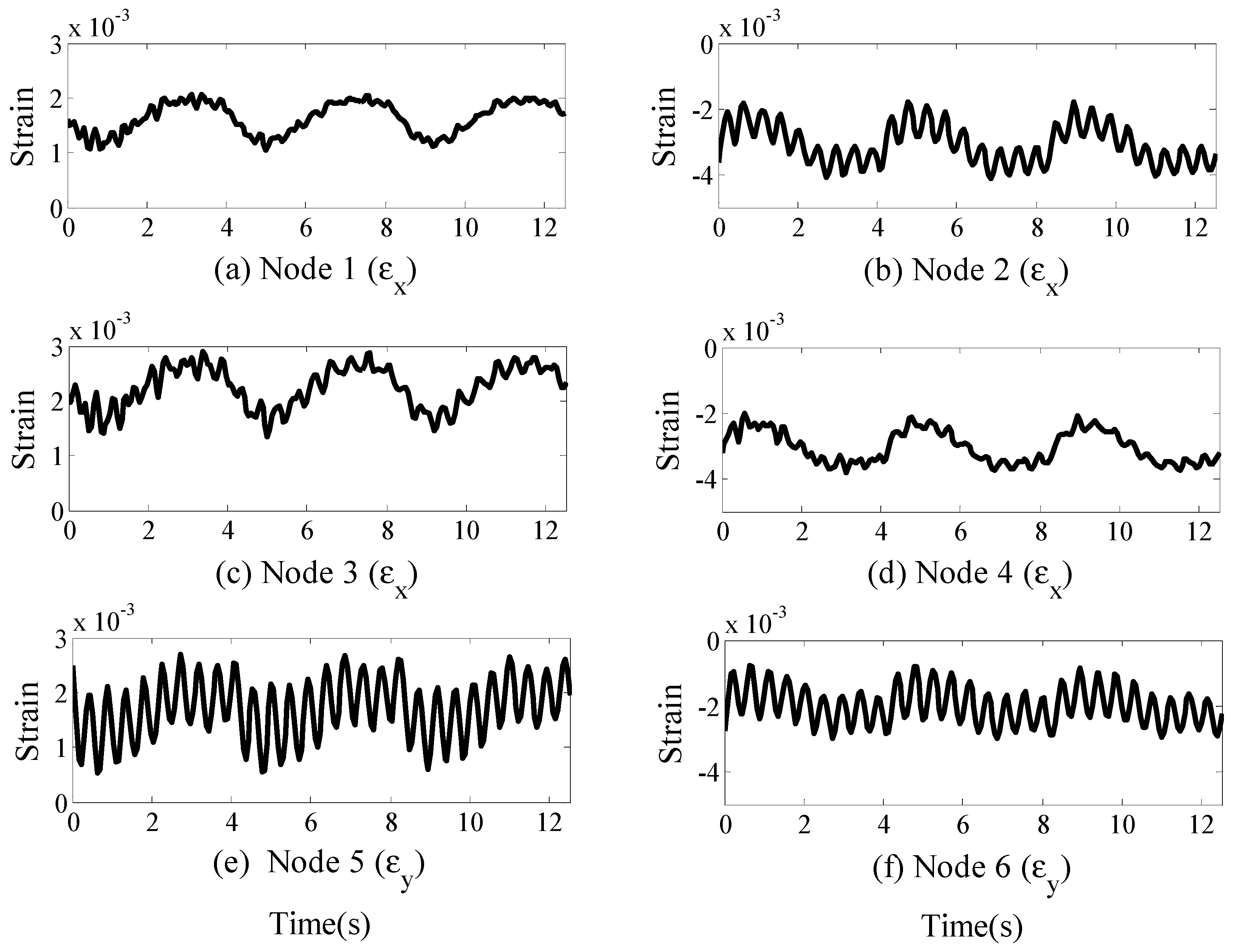
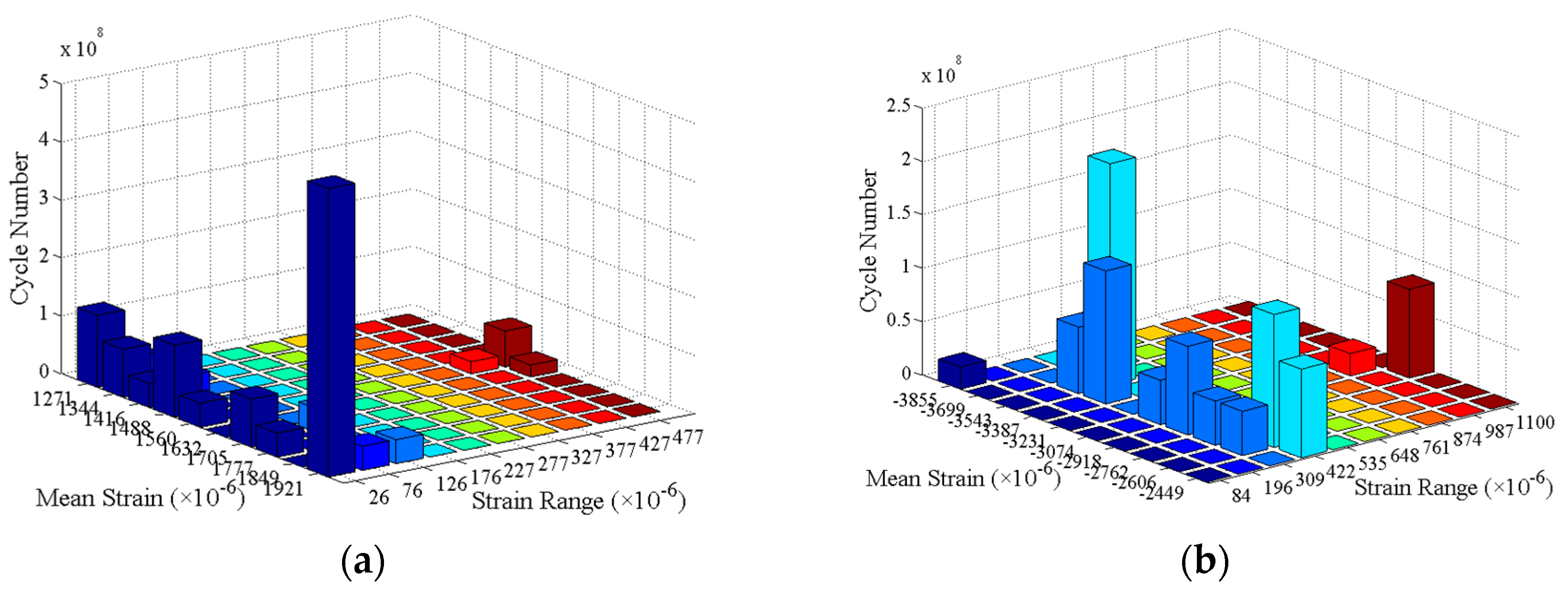
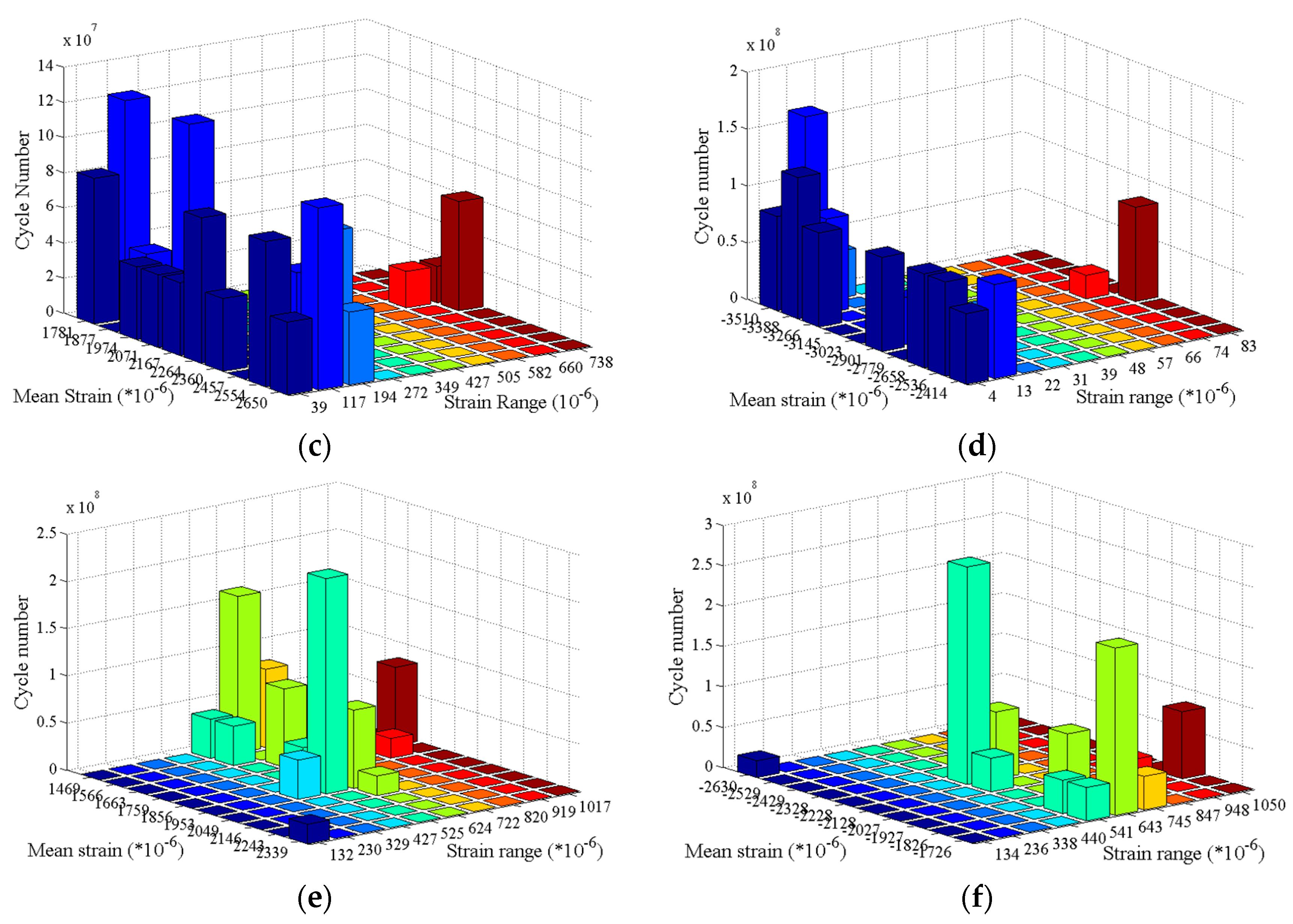
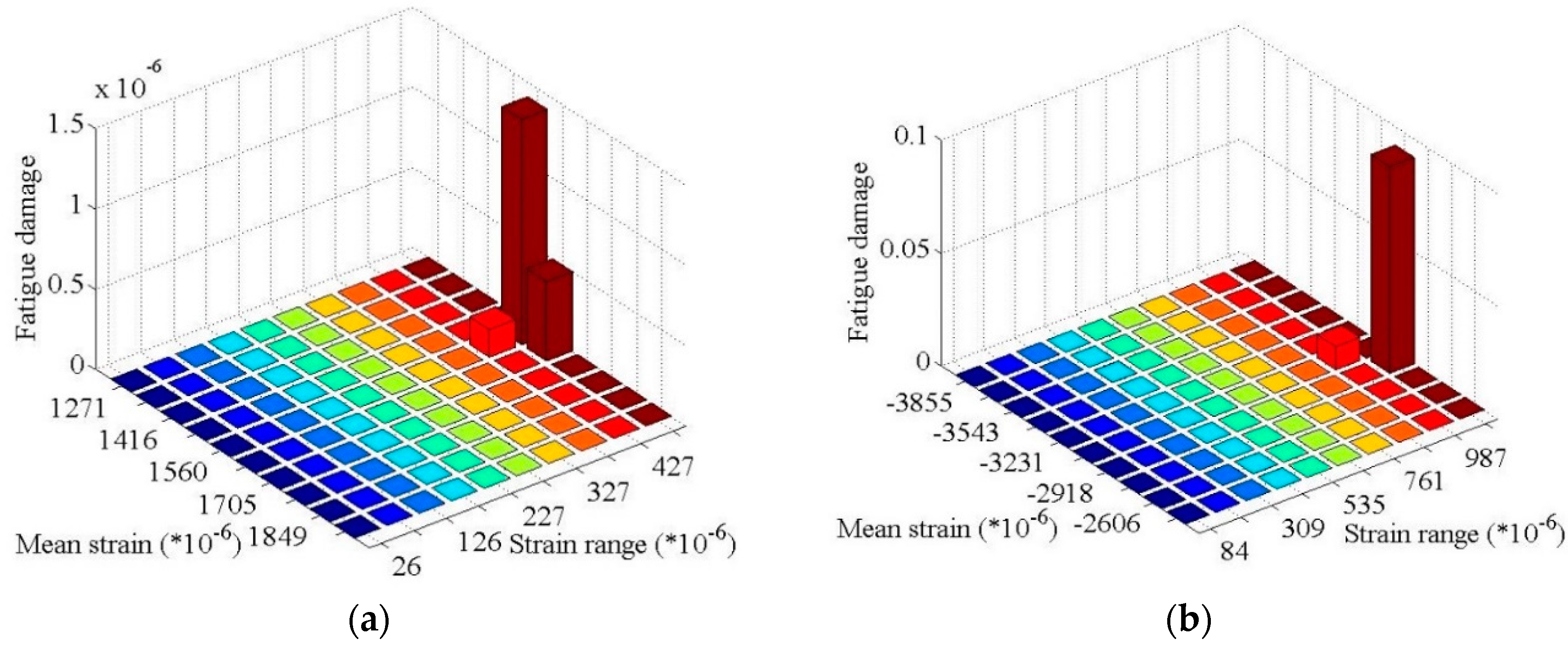
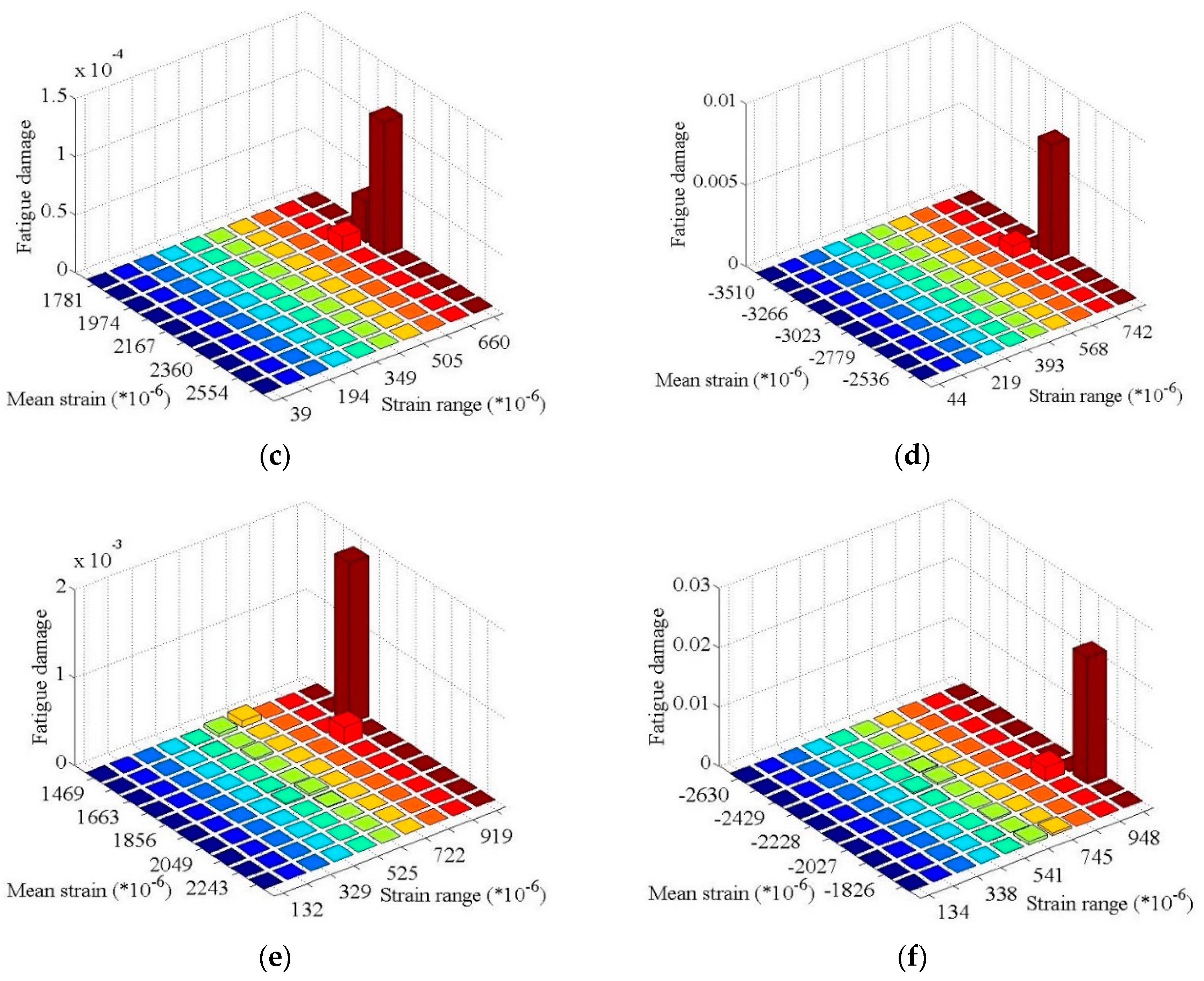
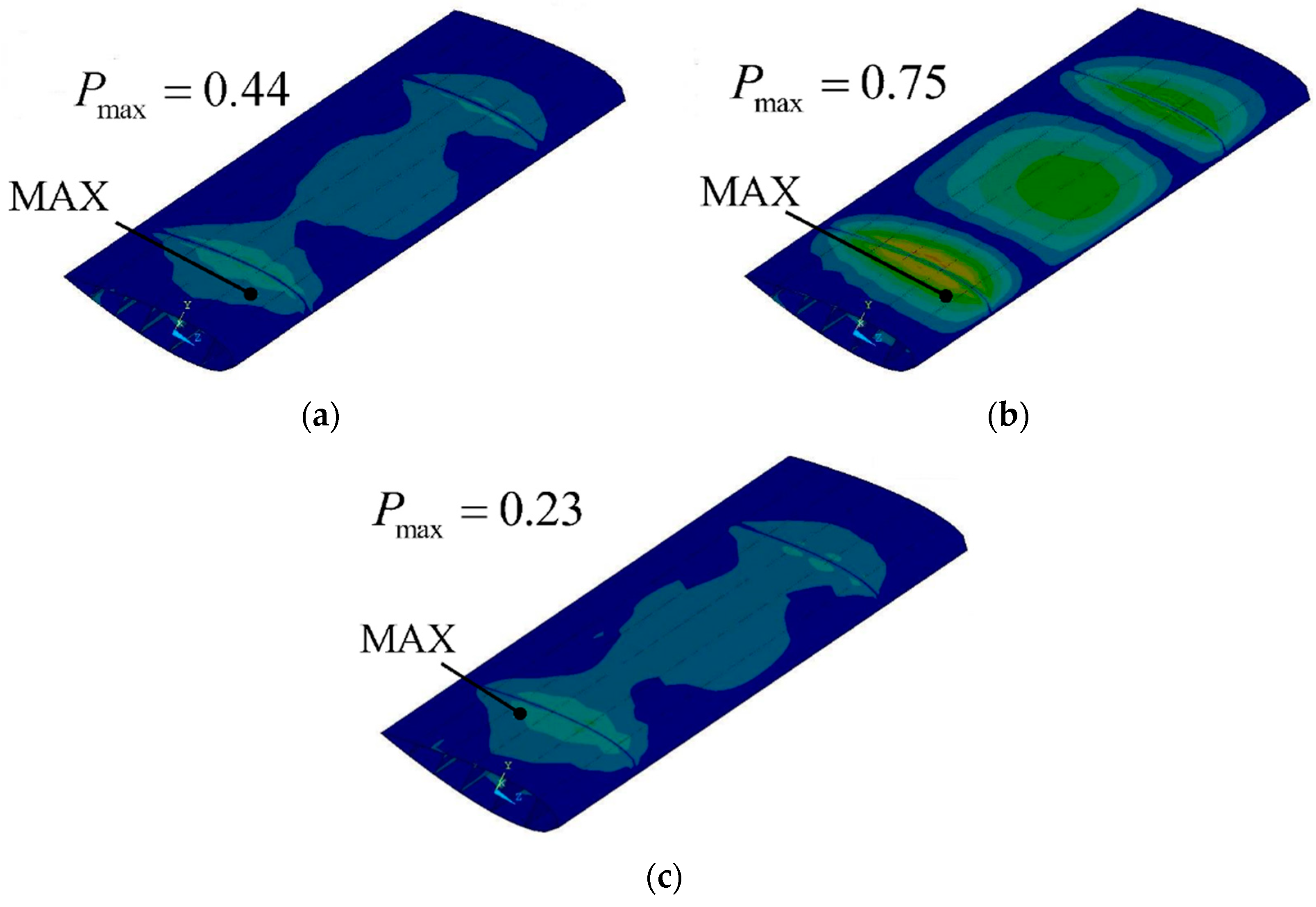

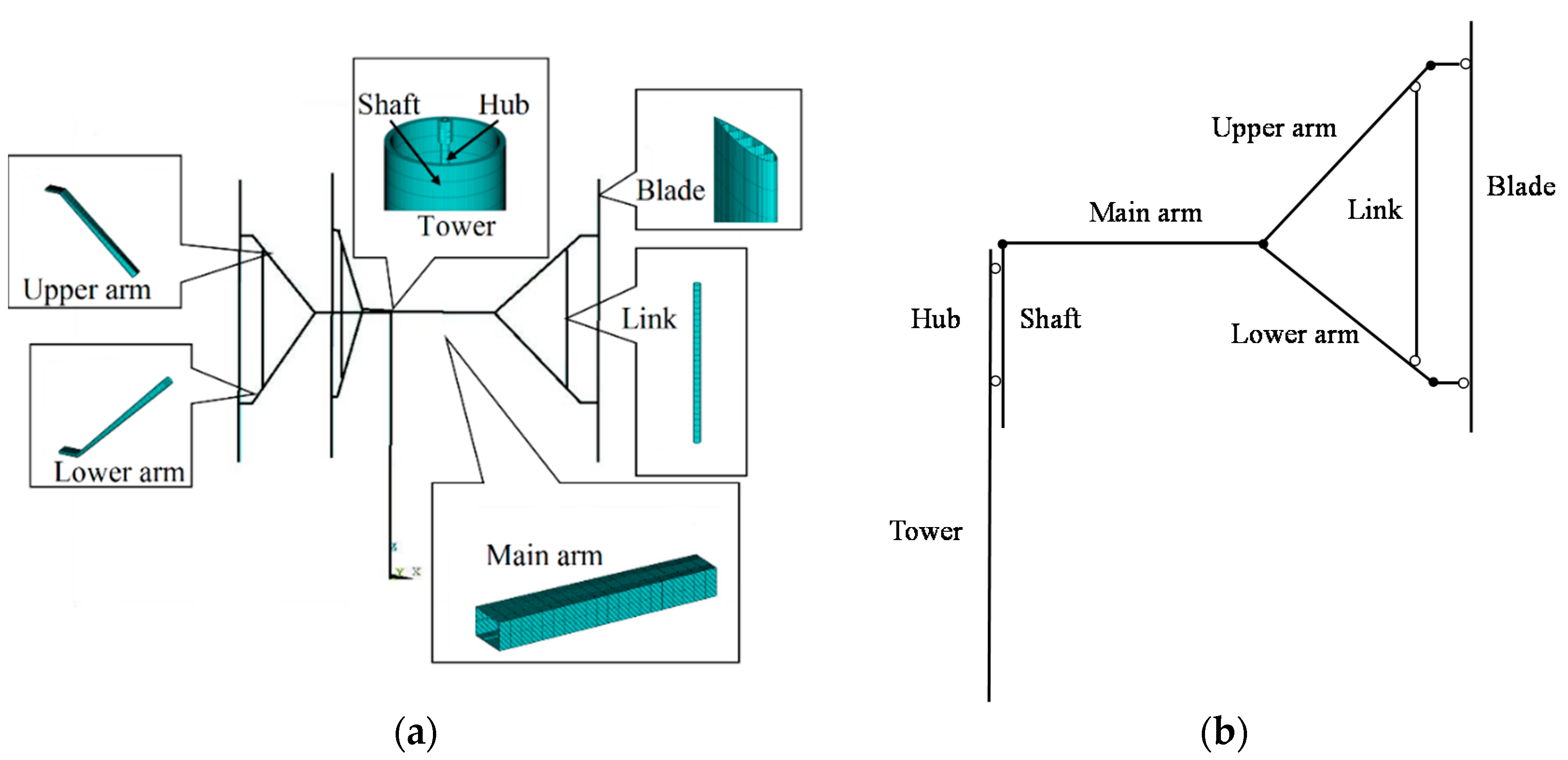
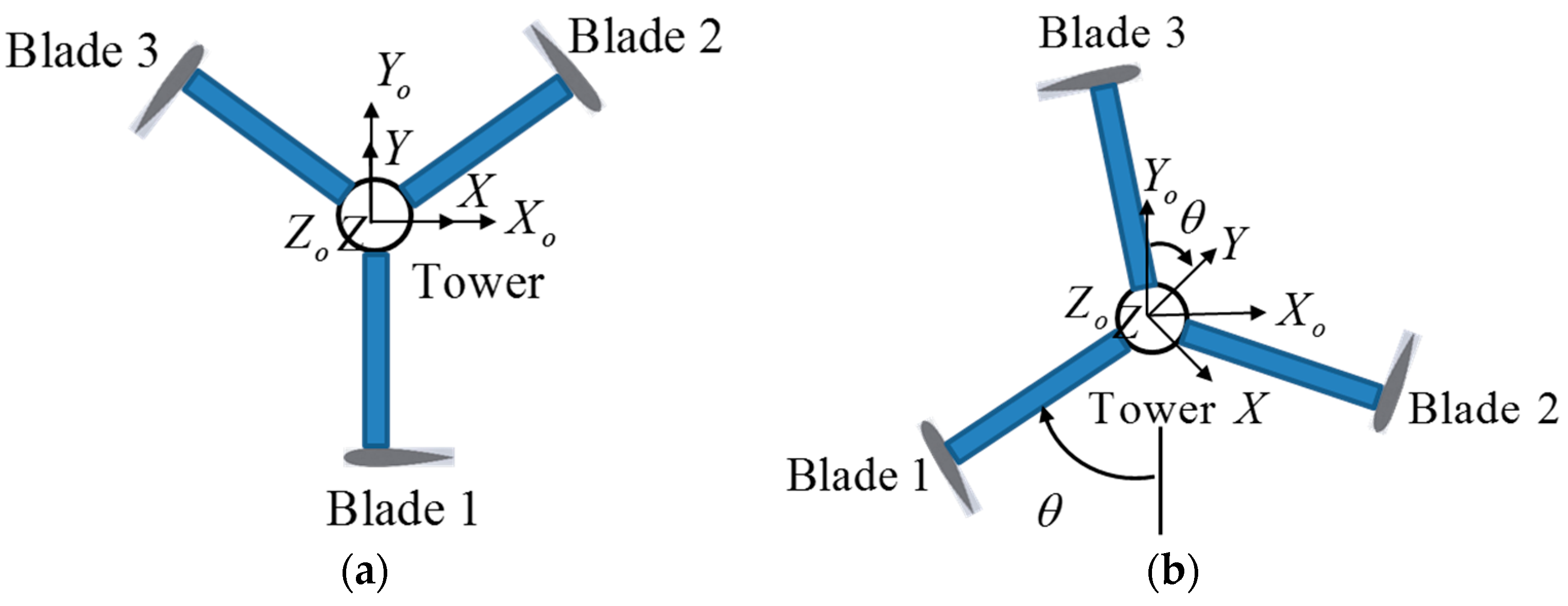

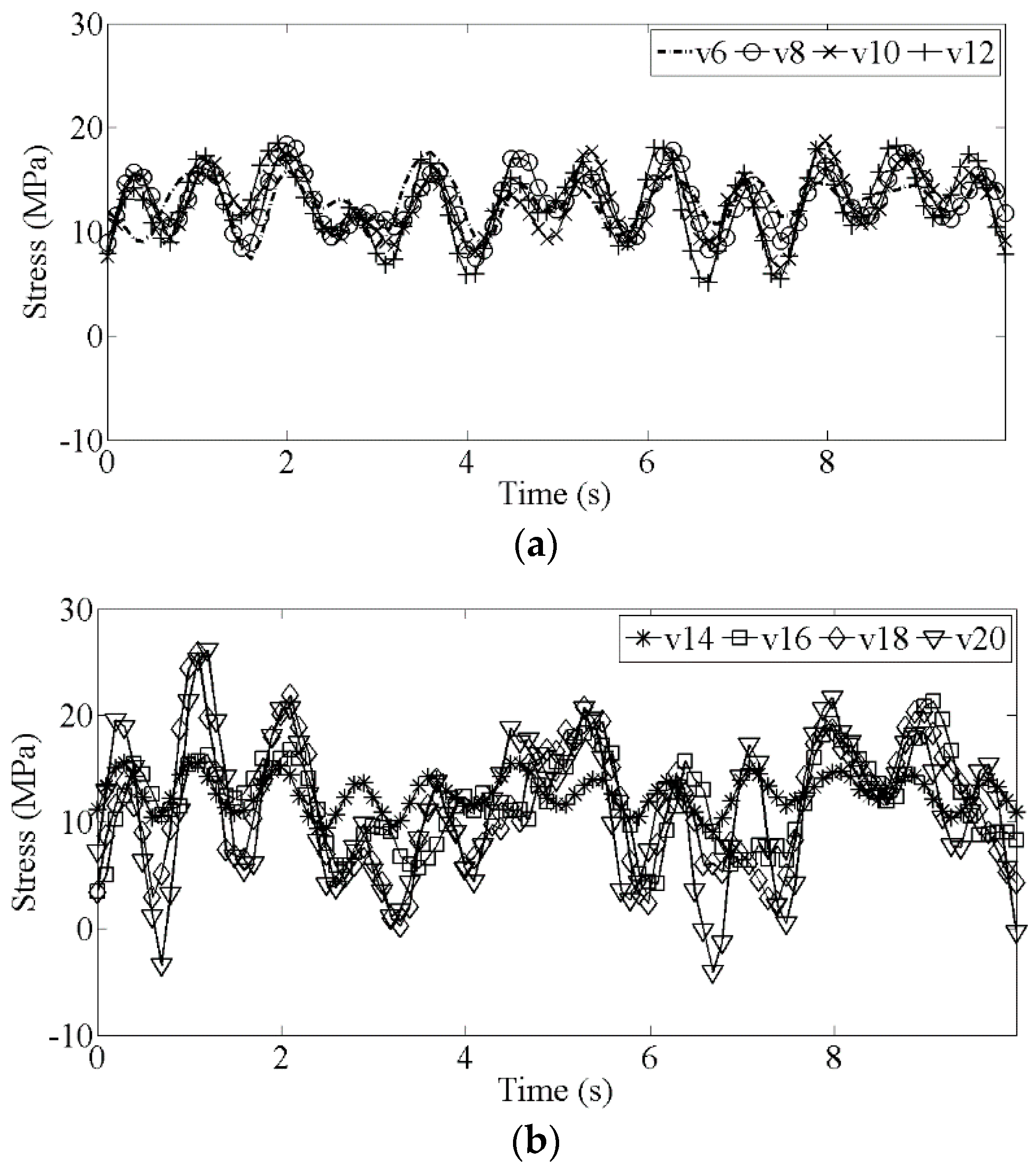

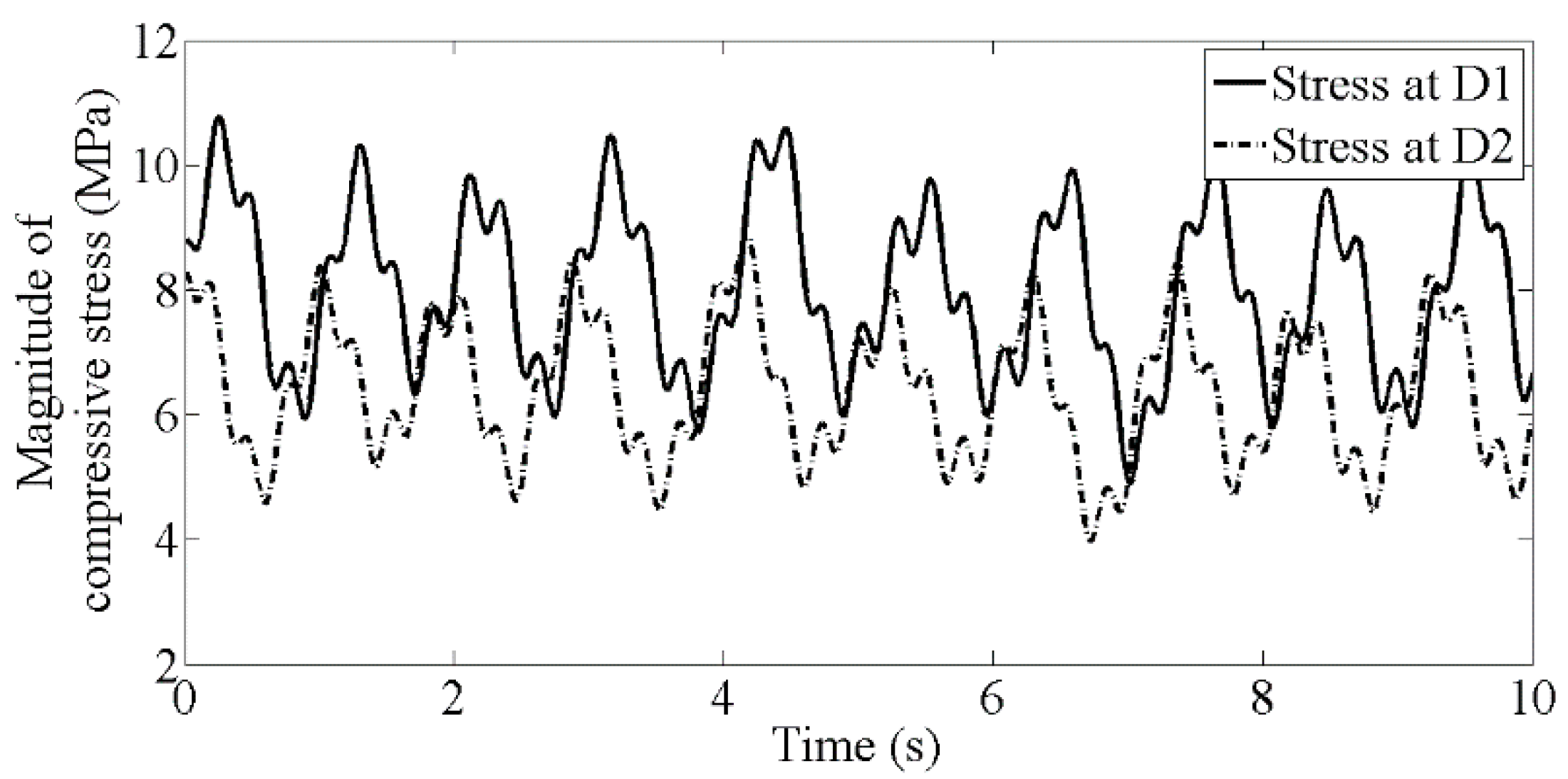

| FRP Type | Ex (GPa) | Ey (GPa) | Ez (GPa) | Gyx (GPa) | Gyz (GPa) | Gzx (GPa) | νyx | νyz | νzx |
|---|---|---|---|---|---|---|---|---|---|
| UD-FRP | 21.00 | 11.61 | 11.61 | 2.73 | 4.07 | 2.73 | 0.31 | 0.17 | 0.31 |
| PW-FRP | 20.97 | 20.97 | 10.90 | 3.46 | 3.38 | 2.09 | 0.18 | 0.46 | 0.46 |
| Node Number | 1 | 2 | 3 | 4 | 5 | 6 |
|---|---|---|---|---|---|---|
| Fatigue damage | 0.4581 × 10−6 | 0.1020 | 0.1626 × 10−3 | 0.0186 | 0.0186 × 10−3 | 0.0122 |
| Component | E (GPa) | ν | ρ (kg/m3) |
|---|---|---|---|
| Tower | 25.74 | 0.20 | 2500 |
| Shaft | 206.00 | 0.30 | 7850 |
| Hub | 25.74 | 0.30 | 2500 |
| Main arms | 164.80 | 0.30 | 7850 |
| Upper and lower arms | 206.00 | 0.30 | 7850 |
| Links | 206.00 | 0.30 | 7850 |
| Blades | 29.20 | 0.30 | 1800 |
| Fatigue Stress | σx,vA | σx,hA | σx,vB | σx,hB | σx,C1 | σx,C2 |
|---|---|---|---|---|---|---|
| Fatigue damage (D) | 0.3476 | 0.2687 | 0.0099 | 0.0088 | 0.0179 | 0.6567 × 10−4 |
© 2019 by the authors. Licensee MDPI, Basel, Switzerland. This article is an open access article distributed under the terms and conditions of the Creative Commons Attribution (CC BY) license (http://creativecommons.org/licenses/by/4.0/).
Share and Cite
Lin, J.; Xu, Y.-l.; Xia, Y. Structural Analysis of Large-Scale Vertical Axis Wind Turbines Part II: Fatigue and Ultimate Strength Analyses. Energies 2019, 12, 2584. https://doi.org/10.3390/en12132584
Lin J, Xu Y-l, Xia Y. Structural Analysis of Large-Scale Vertical Axis Wind Turbines Part II: Fatigue and Ultimate Strength Analyses. Energies. 2019; 12(13):2584. https://doi.org/10.3390/en12132584
Chicago/Turabian StyleLin, Jinghua, You-lin Xu, and Yong Xia. 2019. "Structural Analysis of Large-Scale Vertical Axis Wind Turbines Part II: Fatigue and Ultimate Strength Analyses" Energies 12, no. 13: 2584. https://doi.org/10.3390/en12132584
APA StyleLin, J., Xu, Y.-l., & Xia, Y. (2019). Structural Analysis of Large-Scale Vertical Axis Wind Turbines Part II: Fatigue and Ultimate Strength Analyses. Energies, 12(13), 2584. https://doi.org/10.3390/en12132584





